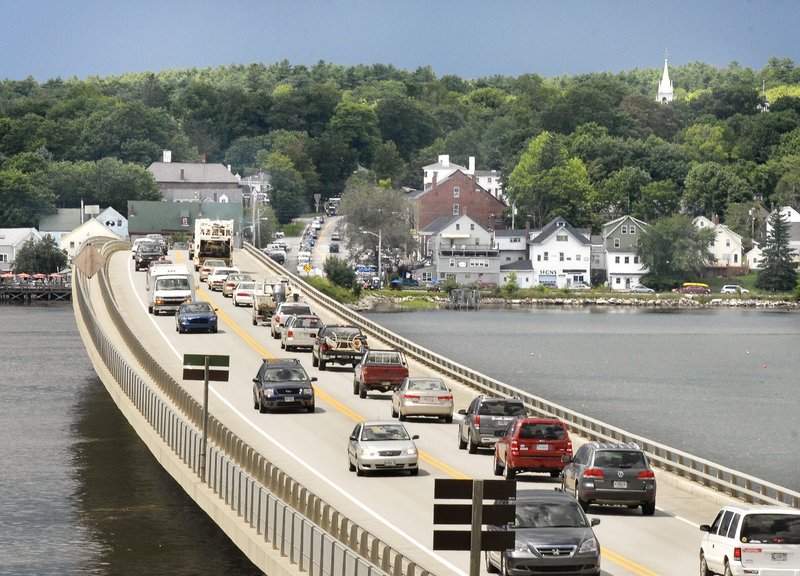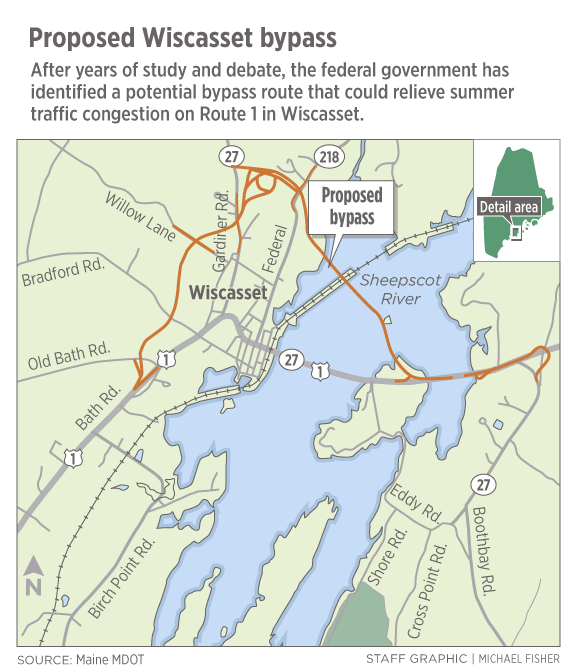WISCASSET – To the list of family traditions in midcoast Maine, add the avocation of trying to build a Route 1 bypass around this historic village, where summer traffic must squeeze through a choke point between now and Labor Day.
Sean Rafter’s late mother, Marguerite, spent 35 years on a local transportation committee that studied solutions. Rafter has served on the panel eight years. He wants to honor his mother’s wish: that her ashes be transported along a new bridge crossing the Sheepscot River.
“We have an urn with some of her ashes, waiting to be driven along the bypass,” he said.
Rafter is 65 years old. Following a meeting here last week, it’s hard to say whether he’ll be able to make the journey, or if he’ll pass the responsibility to his children.
“They may drive my ashes across the bridge,” he said.
Residents have been left wondering, after officials from the Army Corps of Engineers and the Maine Department of Transportation held a briefing Tuesday on a potential bypass route.
It’s a 3.2-mile, limited-access road that would leave Route 1 south of the village and swing north, crossing the river via a 4,150-foot bridge. The route would rejoin the existing highway at Davis Island in Edgecomb, where a DOT maintenance lot now stands.
Not everyone likes this route. In fact, the DOT preferred an option that would have created a longer road but a shorter bridge.
Officials have been considering a bypass since 1958. This is the first time they’ve located a corridor that meets strict federal standards for causing the least environmental damage. It’s the only route with a chance of getting federal permits.
Eager to seize the moment, the DOT has laid out a process to begin surveying the right of way this summer and meeting with property owners who would have their land taken.
But don’t start looking for bypass signs just yet.
The project could cost up to $100 million, and money’s not available now. So the latest idea is to build the bypass in phases.
At the meeting, opinions differed on how long the whole job could take. Ten years is a popular guess, although one official mentioned 25 years.
It’s still not a sure bet that any bypass will be built, even though traffic can back up for miles on a sunny summer weekend. Some local residents have long been opposed to a new highway ripping through town to cure a seasonal headache. Comments at the meeting suggest that opponents will become better organized now that they can focus on a specific route and project.
Here’s another twist: The Corps isn’t as excited about a bypass as the DOT. At the meeting, state highway officials made it clear that no-build, traffic management alternatives have been tried and don’t work.
But the Corps project manager, Jay Clement, said it’s possible that even after identifying the least environmentally destructive route, his agency could decide not to issue a permit. A no-build alternative, he said, remains an option.
Maine people know that highway bypass surgery can take time and cost money:
• The jog around Gorham village was first talked about in the 1950s. It opened two years ago, at a total cost of $29 million.
• Cars and trucks clogged Topsham’s main street until the $45.5 million Coastal Connector opened in 1995.
• Through traffic skirts Augusta today on a third bridge over the Kennebec River, which was built for $34 million in 2004.
Closer to home here, longtime residents recall when downtown Newcastle and Damariscotta were bisected by Route 1, until it was relocated in the 1960s.
Through it all, Wiscasset has defied resolution. It’s now among the longest-pending projects in state history, said Ed Hanscom, a DOT planner.
“All the easy ones have been done,” he mused before last week’s meeting.
The DOT got close a couple of times. The best shot came in 1979, when the agency was reviewing alternative routes and discovered that the wooden piling bridge connecting Wiscasset and Edgecomb was rotting. Bypass money was used to replace the old span with the concrete bridge that stands today.
Last week’s meeting, which was attended by more than 130 people, offered insight to why time keeps on slipping.
For one thing, though the Corps has identified a route with the least impact on the environment — specifically wetlands, streams and wildlife — it hasn’t issued a permit. In fact, the DOT hasn’t submitted state and federal applications. That process can take years.
Gerry Audibert, a DOT project manager, then laid out an ambitious schedule for surveying this summer and starting to buy properties by early next year.
But Audibert also mentioned that the entire job could take 25 years. It was just a guess, but it was well beyond the 10-year time frame that many consider the foreseeable future.
What Clement and Audibert had to say didn’t go over well with several people in the audience.
Question: How can such a big bridge be better for the environment?
Answer: While the route has more visual impact, it’s better for aquatic resources and wildlife.
Question: Wouldn’t a pedestrian overpass in the village improve traffic flow by keeping cars from stopping constantly at the crosswalk?
Answer: That option has been studied. Problems include historic preservation and handicapped access.
One resident asked Audibert: “Is it safe to say, in MDOT’s mind, that the no-build option is off the table?” Audibert replied: “That is correct.”
That response disturbed Larry Gordon, a former selectman. He complained that the state was cutting up the town so a few people from New York could drive faster down the coast. He threatened a petition drive to show the town’s opposition, a challenge that drew applause.
The bypass already has organized opposition. A three-year-old group called R.O.A.D. (Route One Alternative Decisions) wants the state to pursue a range of traffic management alternatives, some of which have already been tried.
Morrison Bonpasse, one of the group’s leaders, said Maine has more pressing highway needs and shouldn’t spend $100 million in Wiscasset.
“When something doesn’t get built for 50 years, there’s a good reason,” he said.
The protracted process has also given pause to Don Jones, who chairs the town’s transportation committee and represented Wiscasset on a regional bypass task force. The group spent three years reaching a consensus on a route, only to be overruled by the Corps.
But Jones also takes a long view. His father, George, was a town official in 1958, when the state first started looking at relocating Route 1.
Jones was asked if he’ll be around to drive across a new bridge. He said he always thought he would be. But after hearing the 25-year guesstimate, Jones, who is 62, began to wonder and did some quick math.
“I’d be 87,” he said, “so maybe not.”
Staff Writer Tux Turkel can be contacted at 791-6462 or at:
tturkel@pressherald.com
Send questions/comments to the editors.





Success. Please wait for the page to reload. If the page does not reload within 5 seconds, please refresh the page.
Enter your email and password to access comments.
Hi, to comment on stories you must . This profile is in addition to your subscription and website login.
Already have a commenting profile? .
Invalid username/password.
Please check your email to confirm and complete your registration.
Only subscribers are eligible to post comments. Please subscribe or login first for digital access. Here’s why.
Use the form below to reset your password. When you've submitted your account email, we will send an email with a reset code.